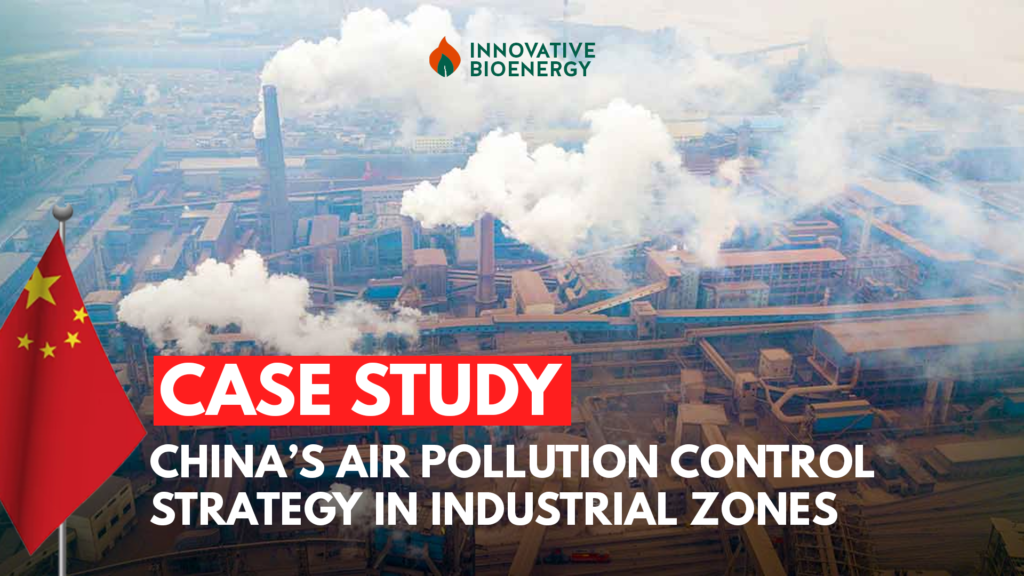China has been battling air pollution for decades, a problem made worse by rapid industrial growth. Industrial pollution from factories and power plants has led to thick smog, health issues, and environmental damage, especially in major industrial zones. Cities like Beijing, Shanghai, and Wuhan often struggled with poor air quality, raising concerns about long-term public health and global climate impact.
To tackle this crisis, China developed a strong air pollution control strategy, aiming to eliminate severe air pollution by 2025. A major part of this strategy focuses on cleaner energy, especially biomass energy, to reduce emissions in industrial areas. This article explores how China controls air pollution in factories, with a spotlight on biomass energy as a key sustainable solution.
1. Background: China’s Industrial Pollution Problem
As the world’s largest manufacturing hub, China has long faced severe pollution from heavy industries like steel, cement, and chemicals. These sectors emit large quantities of fine particulate matter (PM2.5), which refers to tiny airborne particles measuring 2.5 micrometers or less in diameter, small enough to penetrate deep into the lungs and bloodstream, posing serious health risks, By 2020, many cities had failed to meet WHO air quality guidelines, which prompted a policy response from the government
According to the Ministry of Justice of the People’s Republic of China, China committed to reducing PM2.5 concentrations by 10% in major cities, limiting heavily polluted days to under 1% annually, and enforcing stricter environmental laws. These reforms became the backbone of China’s air pollution control strategy in industrial zones.
2. Stronger Emission Standards and Regulations
To clean the air, China tightened environmental regulations in high-pollution industrial areas, particularly:
- Beijing-Tianjin-Hebei
- Yangtze River Delta
- Fenwei Plain
Measures included:
- Upgrading factory systems to meet ultra-low emission (ULE) standards
- Installing advanced filtration systems
- Implementing real-time air monitoring technologies
- Enforcing fuel quality improvements and routine inspections
According to Enviliance ASIA’s report on China’s new action plan, these steps align China’s approach with global best practices and improve accountability within heavy industries.
3. Energy Transition: Biomass Energy Leading the Way to Sustainability
One of the most important components of China’s air quality efforts is its energy transition with biomass energy playing a central role.
What is Biomass Energy?
One of the most transformative components of China’s air quality initiative is its commitment to an energy transition, and biomass energy plays a central role in that shift. Biomass energy is produced by converting agricultural waste, forestry byproducts, and industrial residues into usable fuel forms such as pellets, biogas, or solid fuels for industrial heat generation.
Factories across key zones are replacing coal with biomass, reducing harmful emissions like PM2.5 and SO₂ while promoting a circular economy that transforms waste into energy.
China aims to derive 20% of its total energy consumption from non-fossil fuel sources by 2025. Biomass energy contributes significantly to this target because it is:
- Renewable
- Cost-effective
- Locally available
- Scalable for industrial applications
According to the International Energy Agency (IEA), biomass can provide consistent energy for industrial heating and power, especially in regions lacking wind or solar potential.
4. Improving Transportation and Mobility
Beyond industrial transformation, China has also taken decisive steps to address pollution caused by transportation, a major contributor of NOx and carbon particulates.
Reforms include expanding the use of electric vehicles (EVs) across both public and private sectors, enforcing stricter vehicle emissions standards, and shifting freight movement from roads to more sustainable modes like railways and inland waterways. These transportation initiatives significantly reduce urban air pollution, especially in densely populated industrial metros.
5. Regional Cooperation and Local Success Stories
According to the Energy and Clean Air Journal article on combating smog, China’s success in air pollution control doesn’t stem solely from national policy but also from effective local implementation. A powerful example is the city of Chengdu, which recorded an 18% reduction in PM2.5 levels in 2024.
This achievement came through a combination of dust control at construction sites, widespread adoption of electric vehicles, and strict industrial compliance with emission limits. Such region-specific strategies showcase how local leadership and innovation are essential in achieving national environmental goals.
6. Challenges and the Road Ahead
Despite meaningful progress, China faces ongoing challenges:
- Economic recovery has increased energy demand
- Weather and seasonal factors influence air quality
- Emission standards, while improved, still lag behind WHO guidelines
However, with its continued investments in biomass energy, technological innovation, and policy reform, China is on track to achieve significant environmental gains.
Conclusion: A Cleaner Future with Smart Policies and Sustainable Energy
China’s journey toward cleaner air showcases the power of policy, innovation, and renewable energy. From industrial upgrades to sustainable energy transitions, especially in biomass, the country is rewriting its environmental story.
This case study illustrates that even the world’s largest manufacturing economy can embrace sustainability without sacrificing growth. As China leads the way in sustainable energy transitions, companies worldwide must follow suit. At Innovative Bioenergy, we specialize in converting agricultural and industrial waste into efficient, eco-friendly fuel solutions, helping businesses reduce emissions, save costs, and contribute to a cleaner planet. Contact us and power your industry sustainably.



